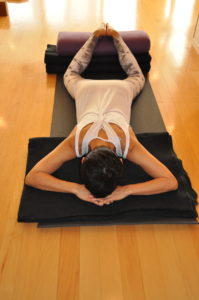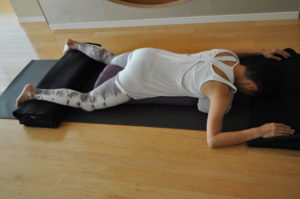
by Leza
Supported Frog pose (Salamba Mandukasana) releases hip tension, stretching the inner thighs, groin, hips, and pelvis. It also releases the lower back, upper back, and shoulders, while providing a gentle stretch to the knees. This pose improves circulation to the hips and thighs, strengthens the back muscles, stimulates the digestive system, and activates the parasympathetic (Rest and Digest) part of the autonomic nervous system. Even though Frog Pose can be intense, it helps to relieve stress, anxiety, and mild depression, promoting calm and well-being.
Caution: Those with hip arthritis, unstable sacroiliac joints, severe back problems, and knee/ ankle injuries should avoid this pose.
Setting Up
To set up for the pose, you’ll need the following: yoga mat, 1-2 bolsters, 2-3 blankets. A sandbag is optional. If you don’t have a bolster, you can use pillows or rolled-up blankets. If you don’t have a sandbag, you can use a bag of rice or other grains.
Start by spreading a yoga mat on the floor. Place a folded blanket at the top of the mat to support your chest, head, and neck. Place a bolster horizontally at the foot of the mat. If more height is needed to support your feet, fold one or more blankets and place them under the bolster. Place a sandbag nearby, if you have one.
To Come into the Pose
 Begin on all fours, with your hands under your shoulders. Make sure both knees are touching the mat, as well as your big toes. Inhale deeply. As you exhale, roll your spine forward over your knees to test your flexibility. Inhale and bring your hips forward. Exhale and gently begin to ease your knees apart from each other as much as they will comfortably allow, while keeping your feet below your knees. Go slowly and don’t push your body.
Begin on all fours, with your hands under your shoulders. Make sure both knees are touching the mat, as well as your big toes. Inhale deeply. As you exhale, roll your spine forward over your knees to test your flexibility. Inhale and bring your hips forward. Exhale and gently begin to ease your knees apart from each other as much as they will comfortably allow, while keeping your feet below your knees. Go slowly and don’t push your body.
When your hips are open to a comfortable degree, slide back so you can put your feet, ankles, and possibly your shins on the bolster or blankets. Do not strain or torque your knees or hips, as this can lead to injury. Flex your feet and, if possible, bring your big toes together. Allow the inside edges of your feet to touch the bolster or blanket. The position of your ankles should be at a slant no greater than 90 degrees below the knee.
Make an arm rest with your hands, placing the right hand over the left to create a nice support for your head and neck. Place your forehead on your hands and elongate the back of your neck. You can try gently tugging the skin of your forehead down toward your eyebrows for extra calming.
Variations
For sensitive knees, fold a blanket or pillow under the knees. For comfort under the head and upper body, use a folded blanket under your head, arms, and chest.
If your shoulders are tight, bring the arms into the prone Cactus position.
 For tight hips, you can place a support (bolster, blanket, or pillow) under the pelvis (bolster, blanket, or pillow). Or you can lie on top of a vertical bolster and place support under your chest. Open your legs and feet wide as shown in the photo above.
For tight hips, you can place a support (bolster, blanket, or pillow) under the pelvis (bolster, blanket, or pillow). Or you can lie on top of a vertical bolster and place support under your chest. Open your legs and feet wide as shown in the photo above.
To relieve back pain and quiet the mind, you can place a sandbag or folded blanket on the back of your pelvis.
 To reduce the intensity, you can do the pose one leg at a time.
To reduce the intensity, you can do the pose one leg at a time.
Trauma-sensitive practitioners should take care to feel safe and contained in this pose. Options include covering the body with a blanket, putting a sandbag or bolster on the lower back, taking the one-legged variation, or abandoning the pose if needed.
Practicing the Pose
Allow your chest to relax into the blanket as you let the shoulder blades draw towards one another. Feel your hip joints open as your pelvis releases down towards the ground. Avoid letting the pelvis pop up.
Bring your attention to the breath. Simply notice the natural flow of your breath coming in and going out. Allow your body to soften, melting into the places it makes contact with the floor or a prop. Let go and release into the support.
After some time, focus on the breath more deeply. As you inhale, consciously expand the back body both upward and outward. As you exhale, release the breath slowly and smoothly, letting the hips, belly, heart, and shoulders release down.
Breath awareness will have a soothing and calming effect on your nervous system. Continue to soften. Allow yourself to feel a sense of gratitude and acceptance. If there is any pain or discomfort, come out of the pose or take a variation.
Stay from 5-10 minutes, as long as there is no discomfort. When you are finished, slowly take your time and push back into a gentle Child’s pose, remaining there for several minutes if possible. Then roll onto your side, with your knees slightly bent. Enjoy a few quiet breaths on your side before pressing your hands into the ground and coming up slowly, vertebrae by vertebrae. Bring your head up last.
The hips are said to be the storehouse of emotions, so be gentle with yourself if you experience strong emotion or emotional release in this pose. Notice what is arising with compassion and kind attention. Seek support and guidance when needed.
You can read more about Leza’s writing at www.lezalowitz.com and about her yoga studio and classes at www.sunandmoon.jp.
• Follow Yoga for Healthy Aging on Facebook and follow Nina on Instagram •Pre-order Yoga for Times of Change: Practices and Meditations for Moving Through Stress, Anxiety, Grief & Life’s Transitions here. • Order Yoga for Healthy Aging: A Guide to Lifelong Well-Being here.


Leave A Comment